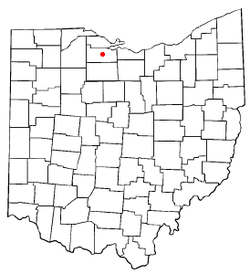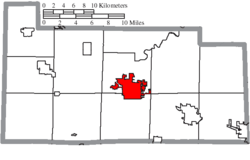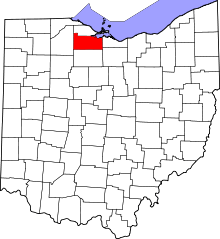Fremont, Ohio
| Fremont, Ohio | |
|---|---|
| City | |
|
Downtown Fremont, Ohio on South Front Street. | |
| Nickname(s): Cutlery Capitol of the World[1] | |
| Motto: "Where People Come First" | |
 Location of Fremont, Ohio | |
 Location of Fremont in Sandusky County | |
| Coordinates: 41°20′56″N 83°7′2″W / 41.34889°N 83.11722°WCoordinates: 41°20′56″N 83°7′2″W / 41.34889°N 83.11722°W | |
| Country | United States |
| State | Ohio |
| County | Sandusky |
| Government | |
| • Mayor | Danny Sanchez (R) |
| Area[2] | |
| • Total | 8.57 sq mi (22.20 km2) |
| • Land | 8.35 sq mi (21.63 km2) |
| • Water | 0.22 sq mi (0.57 km2) |
| Elevation[3] | 627 ft (191 m) |
| Population (2010)[4] | |
| • Total | 16,734 |
| • Estimate (2012[5]) | 16,564 |
| • Density | 2,004.1/sq mi (773.8/km2) |
| Time zone | Eastern (EST) (UTC-5) |
| • Summer (DST) | EDT (UTC-4) |
| ZIP code | 43420 |
| Area code(s) | 419, 567 |
| FIPS code | 39-28826[6] |
| GNIS feature ID | 1040674[3] |
| Website | http://www.fremontohio.org/ |

Fremont is a city in and the county seat of Sandusky County, Ohio, United States.[8] The population was 16,734 at the 2010 census. It was the home of Rutherford B. Hayes, who served as President of the United States from 1877 to 1881. The Rutherford B. Hayes Presidential Center remains one of the focal points of Fremont, OH. The National Arbor Day Foundation designated Fremont as a Tree City USA.[9]
History
The area which is now Fremont was originally a Wyandot village. In the 1750s a French trading post was established there. In 1787 the United States established the Northwest Territory, and in 1803 the southeastern portion of the Territory was admitted to the Union as part of the new state of Ohio. During the early and mid 1800s a few Europeans and African Americans, predominantly runaway slaves, settled in the area, which became known as Lower Sandusky for its location on the Sandusky River. Under the terms of Ohio's admission, Lower Sandusky was defined as Indian Territory, so the non-Wyandot settlements were in direct violation of the Treaty of Greeneville; at one point the United States Army considered removing the settlers by force, but did not carry out the threat.[10] Fort Stephenson was built there during the War of 1812, and the Battle of Fort Stephenson was fought there in August 1813.[11]
In 1821 Lower Sandusky became the county seat of Sandusky County. The town gradually expanded, with primary occupations being shipbuilding, fishing, and agricultural processing. In 1849 the residents changed the name of Lower Sandusky to Fremont, in honor of John C. Frémont.[12] In 1873 future president Rutherford B. Hayes moved into a family home in Fremont called Spiegel Grove. The home is now part of the Rutherford B. Hayes Presidential Center, the first presidential library in the United States (founded in 1916).[10]
Geography
Fremont is located at 41°20′56″N 83°7′2″W / 41.34889°N 83.11722°W (41.348909, -83.117123),[13] along the Sandusky River.
The city has a total area of 8.57 square miles (22.20 km2), of which 8.35 square miles (21.63 km2) is land and 0.22 square miles (0.57 km2) is water.[2]
Demographics
| Historical population | |||
|---|---|---|---|
| Census | Pop. | %± | |
| 1830 | 351 | — | |
| 1840 | 1,117 | 218.2% | |
| 1850 | 1,464 | 31.1% | |
| 1860 | 3,510 | 139.8% | |
| 1870 | 5,455 | 55.4% | |
| 1880 | 8,440 | 54.7% | |
| 1890 | 7,141 | −15.4% | |
| 1900 | 8,439 | 18.2% | |
| 1910 | 9,939 | 17.8% | |
| 1920 | 12,468 | 25.4% | |
| 1930 | 13,422 | 7.7% | |
| 1940 | 14,710 | 9.6% | |
| 1950 | 16,537 | 12.4% | |
| 1960 | 18,767 | 13.5% | |
| 1970 | 18,490 | −1.5% | |
| 1980 | 17,887 | −3.3% | |
| 1990 | 17,648 | −1.3% | |
| 2000 | 17,375 | −1.5% | |
| 2010 | 16,734 | −3.7% | |
| Est. 2015 | 16,297 | [14] | −2.6% |
| Sources:[6][15][16][17] | |||
2010 census
As of the census[4] of 2010, there were 16,734 people, 6,745 households, and 4,162 families residing in the city. The population density was 2,004.1 inhabitants per square mile (773.8/km2). There were 7,541 housing units at an average density of 903.1 per square mile (348.7/km2). The racial makeup of the city was 80.7% White, 8.3% African American, 0.2% Native American, 0.3% Asian, 5.3% from other races, and 5.1% from two or more races. Hispanic or Latino of any race were 16.1% of the population.
There were 6,745 households of which 34.2% had children under the age of 18 living with them, 37.1% were married couples living together, 18.7% had a female householder with no husband present, 5.9% had a male householder with no wife present, and 38.3% were non-families. 32.5% of all households were made up of individuals and 12% had someone living alone who was 65 years of age or older. The average household size was 2.42 and the average family size was 3.04.
The median age in the city was 35.3 years. 27.2% of residents were under the age of 18; 8.6% were between the ages of 18 and 24; 25.7% were from 25 to 44; 24.7% were from 45 to 64; and 13.9% were 65 years of age or older. The gender makeup of the city was 47.8% male and 52.2% female.
2000 census
As of the census[6] of 2000, there were 17,375 people, 6,856 households, and 4,374 families residing in the city. The population density was 2,313.1 people per square mile (893.3/km²). There were 7,368 housing units at an average density of 980.9 per square mile (378.8/km²). The racial makeup of the city was 82.24% White, 8.29% African American, 0.18% Native American, 0.24% Asian, 5.85% from other races, and 3.19% from two or more races. Hispanic or Latino of any race were 12.32% of the population.
There were 6,856 households out of which 33.6% had children under the age of 18 living with them, 42.5% were married couples living together, 16.4% had a female householder with no husband present, and 36.2% were non-families. 30.4% of all households were made up of individuals and 12.8% had someone living alone who was 65 years of age or older. The average household size was 2.46 and the average family size was 3.06.
In the city the population was spread out with 27.6% under the age of 18, 10.0% from 18 to 24, 28.7% from 25 to 44, 19.3% from 45 to 64, and 14.4% who were 65 years of age or older. The median age was 34 years. For every 100 females there were 89.9 males. For every 100 females age 18 and over, there were 85.0 males.
The median income for a household in the city was $34,051, and the median income for a family was $39,439. Males had a median income of $32,453 versus $22,048 for females. The per capita income for the city was $16,014. About 9.8% of families and 12.9% of the population were below the poverty line, including 16.8% of those under age 18 and 9.9% of those age 65 or over.
Economy
A Heinz ketchup plant is located in this town and is active. The city was also home to several cutlery companies The Christy Company, Clauss Cutlery Company, Quikut, B.A.P. Manufacturing, and the Ginsu Cutlery Line and Herbrand tools. It was the home to a Pioneer Sugar processing plant until it closed in 1997.
Arts and culture
.jpg)
Annual cultural events
- May 17–19, 2012: 1st Annual Sandusky County Arts and Music Festival
- June 16, 2012: Farmer's Market and the Fremont Federal Credit Union Car Show
- July 21, 2012: Farmer's Market featuring the AEP Ohio Art and Music Fest
- August 4, 2012: Farmer's Market and the Fremont Athletic Supply Front Street Relay!
- August 18, 2012: Farmer's Market and the Green Bay Packaging Dog Days of Summer
- September 15, 2012: Farmer's Market and the Croghan Colonial Bank Service Club Olympics
- October 6, 2012: Farmer's Market and the Kid's Market
- October 20, 2012: Farmer's Market and the Memorial Health Care System Scarecrow Contest
Landmarks
- Birchard Public Library (former site of Fort Stephenson)
- H. J. Heinz Company ketchup factory (the world's largest ketchup factory)
- Rutherford B. Hayes Presidential Center
- Sandusky County Jail and Sheriff's House
- Spiegel Grove
- Fremont Speedway
Historic downtown Fremont
Downtown Fremont is located next to the Sandusky River on Front Street. Front Street is home to many small businesses that include boutiques, gift shops, restaurants, and many other attractions fully listed below. Downtown Fremont, although it has been through many economic ups and downs has been the center point of the city for many years.
Government
The mayor of Fremont is Danny Sanchez, a Republican.
Education
Fremont City School District enrolls 4,198 students in public primary and secondary schools.[18] The district administers seven elementary schools, one middle school, and one high school, Fremont Ross. The city is home to one private Catholic high school, SJCC, and Temple Christian Academy operated by Fremont Baptist Temple (www.tcafremont.org),and to Terra Community College.
Media
Fremont's daily newspaper is The News-Messenger. WFRO-FM (99.1 FM) "Eagle 99" broadcasts from Fremont.
Infrastructure
Transportation
The Norfolk Southern railroad serves the city. It uses parts of two defunct railroads as spurs to factories.

Two long-distance US routes run through Fremont, U.S. Route 6 and U.S. Route 20. State Routes 12, 19, 53 and 412 also pass through or terminate in the Fremont area. None of these routes actually pass through Fremont. Instead, they are all multiplexed on a bypass of the city, most of which is 4 lanes. The bypass has both grade level crossings and controlled access interchanges. Prior to the completion of the bypass in the late 1950s, all of these routes passed through Fremont. Their former alignments are currently signed as "City Route (number)" with the number being that of the predecessor highway.[19]
The Ohio Turnpike, another long-distance east west route, passes approximately 4 miles north of the city. The Turnpike is signed as Interstates 80 and 90. Exit 91 (originally Exit 6) links the Turnpike to Fremont via State Route 53.
Health care
Notable people
- Tom Beier, National Football League player, All American College Football
- Bob Brudzinski, National Football League player
- Clarence Childs, 1912 US Olympic Team, Bronze Medal, Hammer Throw
- Mark Coleman, mixed martial artist, UFC Champion, 1992 US Olympic Team, Wrestling
- Everton Conger, capturer of John Wilkes Booth
- Dana DeMuth, Major League Baseball umpire
- Paul Dietzel, American college football coach
- Doug Gallagher, Major League Baseball pitcher, Detroit Tigers
- Robert W. Hines, National Wildlife Artist for the U.S. Fish and Wildlife Service
- Alice E. Johnson, architect
- Carla F. Kim, Associate Professor of Genetics at Harvard Medical School
- Robert Knepper, Actor, role of "T-Bag" in the Prison Break television series
- Tony Little, television fitness personality
- Rob Lytle, National Football League player, Denver Broncos
- Shawn McCarthy, National Football League player, New England Patriots
- Walter R. Nickel, dermatologist
- Myles Porter, 2012 US ParaOlympic Team, Silver Medalist, Judo
- Charles Woodson, National Football League player
- Jacob Wukie, US Archery Team recurve archer, 2012 Olympic Silver Medal Winner
References
- ↑ Sandusky County Historical Society. "Fremont Native Charles Stilwell: Inventor of the Self-Opening Sack". Retrieved 2010-09-05.
- 1 2 "US Gazetteer files 2010". United States Census Bureau. Retrieved 2013-01-06.
- 1 2 "US Board on Geographic Names". United States Geological Survey. 2007-10-25. Retrieved 2008-01-31.
- 1 2 "American FactFinder". United States Census Bureau. Retrieved 2013-01-06.
- ↑ "Population Estimates". United States Census Bureau. Retrieved 2013-06-17.
- 1 2 3 "American FactFinder". United States Census Bureau. Retrieved 2008-01-31.
- ↑ Lossing, Benson (1868). The Pictorial Field-Book of the War of 1812. Harper & Brothers, Publishers. p. 500.
- ↑ "Find a County". National Association of Counties. Retrieved 2011-06-07.
- ↑ Ohio
- 1 2 "Fremont, Ohio". Ohio History Central. Retrieved 27 December 2013.
- ↑ Gilpin, Alec R. (1958). The War of 1812 in the Old Northwest (1968 reprint ed.). East Lansing, MI: The Michigan State University Press. p. 207.
- ↑ Gannett, Henry (1905). The Origin of Certain Place Names in the United States. Govt. Print. Off. p. 132.
- ↑ "US Gazetteer files: 2010, 2000, and 1990". United States Census Bureau. 2011-02-12. Retrieved 2011-04-23.
- ↑ "Annual Estimates of the Resident Population for Incorporated Places: April 1, 2010 to July 1, 2015". Retrieved July 2, 2016.
- ↑ "Number of Inhabitants: Ohio" (PDF). 18th Census of the United States. U.S. Census Bureau. Retrieved 22 November 2013.
- ↑ "Ohio: Population and Housing Unit Counts" (PDF). U.S. Census Bureau. Retrieved 22 November 2013.
- ↑ "Incorporated Places and Minor Civil Divisions Datasets: Subcounty Population Estimates: April 1, 2010 to July 1, 2012". U.S. Census Bureau. Retrieved 25 November 2013.
- ↑ greatschools. "Fremont City School District Profile". Retrieved 2013-12-04.
- ↑ Gulyas, Sandor (December 8, 2003). "Fremont Photos". The Ohio Regional Road Pages. Retrieved July 1, 2013.
External links
- City website
- Fremont, Ohio at Ohio History Central
- Fremont, Ohio at DMOZ
- Downtown Fremont Website
